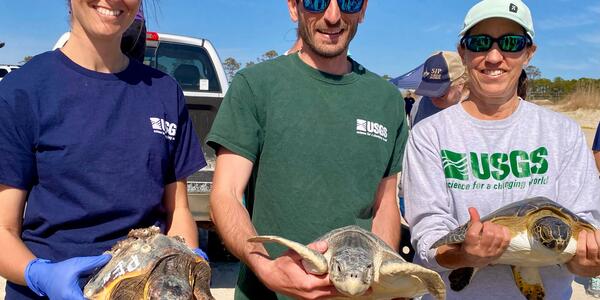
Between January 21 and January 26, U.S. Geological Survey experts, working with partners, volunteers, and community members from Port St. Joe, rescued endangered or threatened sea turtles that were in jeopardy due to cold water temperatures. The rescued turtles were then transported to Gulf World Marine Institute, where they were rehabilitated until water temperatures returned to safe levels for the turtles. Experts began releasing the turtles starting January 27 with most releases completed by January 31.
Sea turtles are cold-blooded and can become “cold stunned” when water temperatures drop below 50 degrees. Once temperatures drop too low, sea turtles are unable to swim or keep their heads above the water to breathe. This can lead to sea turtle deaths from drowning or from their inability to fend off predators.
In addition to saving the turtles, scientists also tagged them before releasing them.
“In a normal year, we can only tag around 100 sea turtles, so in addition to saving the lives of these endangered or threated sea turtles, this rescue has tremendous scientific value from the large number of turtles we tagged,” said Samantha Snow, a USGS biologist, who along with her supervisor Dr. Margaret Lamont and team members Dan Catizone, Joseph Alday and Carson Alday, led the rescue efforts.
By tagging and measuring the cold stunned sea turtles, experts can then track those turtles over time to determine their growth and movement patterns. Tagging also provides information used to create models that provide population estimates. These data are used by managers working to create recovery plans for sea turtles.
Snow added that this was one of the largest turtle rescues in Florida history and was only made possible because of the collaborative efforts of all the agencies involved, local community members from Port St. Joe, Florida, and almost 70 volunteers.
“It’s incredible how much the volunteers and local community care about the turtles,” said Margaret Lamont, a USGS research biologist and sea turtle expert. “So many people in this small town just pulled together to help the effort and it would not have been possible without them.”
In addition to volunteers and community members, partners from the U.S. Fish and Wildlife Service, National Oceanic and Atmospheric Administration, Eglin and Tyndall Air Force Bases, Florida Fish and Wildlife Conservation Commission, and several non-profit organizations also participated in the rescue.
To learn more about USGS sea turtle research, please visit the USGS sea turtle project page: https://www.usgs.gov/centers/wetland-and-aquatic-research-center/science/science-topics/sea-turtles.
This United States Geological Survey news article "Almost 1,000 sea turtles returned to the wild after being saved from frigid water in Florida" was originally found on https://www.usgs.gov/news

